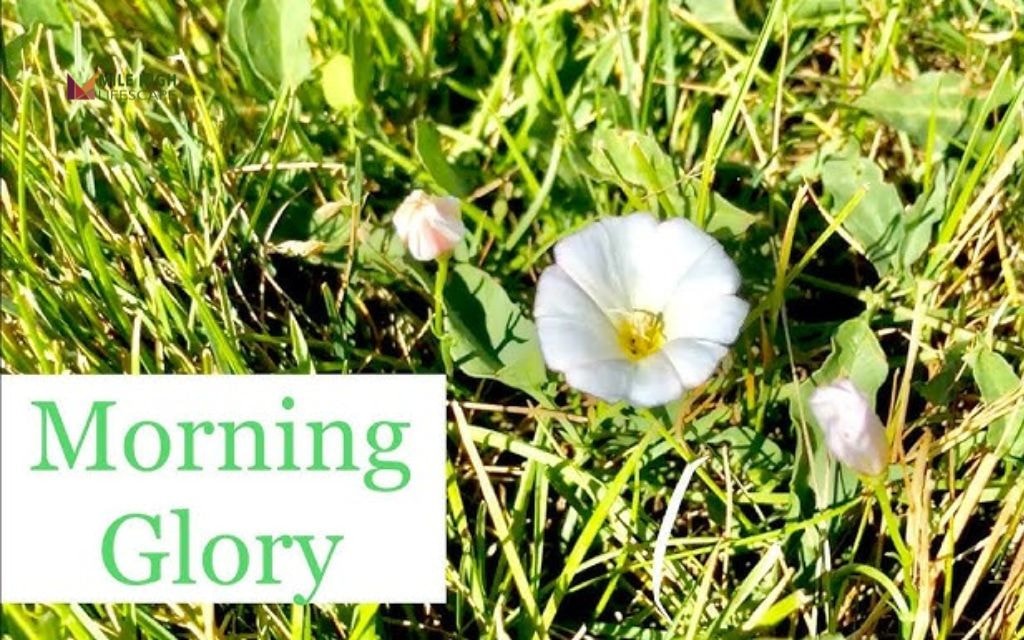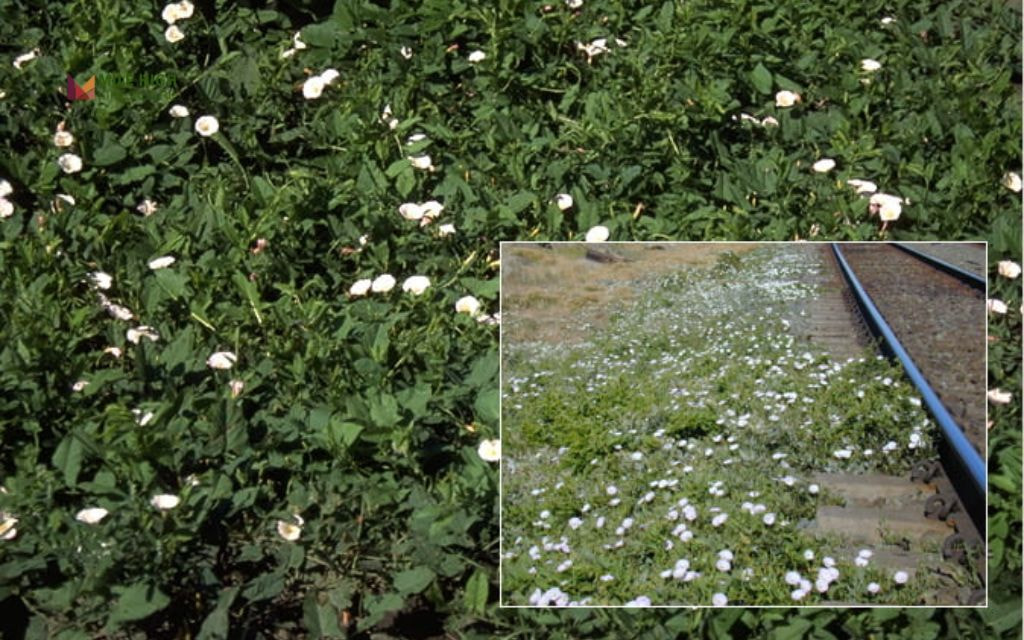To get rid of morning glory, focus on preventing seed production, smothering existing plants, or using herbicides. Pulling or digging up the plants is also effective if done consistently, especially when the plant is young.
Morning glory (Ipomoea species) and its aggressive cousin, field bindweed (Convolvulus arvensis), are notorious for overgrowing gardens across Denver and the Colorado Front Range.
The challenge with morning glory lies in its survival mechanisms. The plant produces thousands of seeds that remain viable in soil for decades. Its root system extends up to 20 feet deep, with fragments as small as an inch capable of generating new plants present a real challenge for even the most diligent gardeners.
This guide will help you identify morning glory in your yard, implement effective removal techniques, prevent future infestations, and determine when professional intervention makes sense for your situation.
How to Identify Morning Glory in Your Yard
Before launching your removal strategy, confirm you’re dealing with morning glory by looking for these distinctive characteristics:
Visual characteristics
- Trumpet or funnel-shaped flowers in purple, pink, blue, or white
- Vining growth pattern with stems that twist counterclockwise
- Heart-shaped leaves arranged alternately along stems
- Extensive underground root system with white, cord-like appearance
Behavior signs
- Aggressive twining around other plants, fences, and structures
- Rapid spread even in poor soil conditions
- Resurgence after incomplete removal attempts
- Early morning flowering that closes in afternoon heat
Field bindweed, the most troublesome variety in Denver, features smaller flowers (about 1 inch) than ornamental morning glories and demonstrates remarkable drought tolerance. This adaptation makes it particularly resilient in Colorado’s climate.

How Do You Get Rid of Morning Glory? 12 Solutions To Apply
Eradicating morning glory requires patience and a multi-faceted approach. Here are 10 proven techniques effective for Denver’s unique growing conditions:
#1: Manual Removal
Pull young plants carefully by hand, removing as much root structure as possible. The key to success lies in persistence – inspect and remove new growth weekly, as broken roots regenerate quickly.
Morning glory removal works best after rain when soil loosens its grip on root systems. For smaller infestations, use a garden trowel to loosen soil around the plant before pulling, which helps extract more of the root. Place removed plants in sealed plastic bags rather than composting to prevent further spread.
#2: Deep Digging
For established plants, dig 6-12 inches deep to extract the maximum root mass. Use a garden fork instead of a shovel to reduce root breakage. Sift through the soil to remove white, thread-like roots that break easily.
In Denver’s clay-heavy soils, consider amending with compost after removal to improve soil structure. In heavily infested areas, repeated digging sessions every 2-3 weeks throughout a growing season may be necessary.
#3: Smothering Technique
Lay heavy mulch, landscape fabric, or black plastic over infested areas to block sunlight. This method proves most effective when maintained for 4-6 months during the growing season.
The high-altitude sunlight in Denver intensifies this effect, particularly during summer months. When using plastic, secure edges with rocks or soil to prevent wind displacement.
For landscape fabric, use a heavy-duty grade and overlap seams by at least 12 inches. Apply 4-6 inches of mulch over fabric for best results. This method works well for garden borders and fence lines where morning glory typically first appears.
With over 20 years of landscaping experience in Denver, Mile High Lifescape offers mulch installation services tailored to Colorado’s distinct environmental needs. Although DIY mulching may appear easy, having it done by professionals guarantees you enjoy all the advantages that proper mulching can bring to your Colorado landscape.
#4: Organic Vinegar Solution
Apply 20% horticultural vinegar directly to foliage on sunny days for maximum effectiveness. This contact-based approach burns foliage but requires careful application to avoid damaging desirable plants. Add 1 tablespoon of dish soap to help the solution stick to waxy leaves.
Note that while effective on foliage, vinegar doesn’t kill deep roots, so combine this method with other approaches for complete control.
#5: Herbicide Application
For severe infestations, selective herbicides containing glyphosate provide effective control. Apply in late summer to early fall when plants actively transport nutrients to roots.
Follow label instructions precisely and consider spot-treatment methods to minimize environmental impact.
Apply herbicides on calm days to prevent drift, and avoid application before rain or irrigation, which reduces effectiveness. For persistent patches, combine fall and spring applications over multiple seasons.

#6: Boiling Water Treatment
Pour boiling water directly onto crown and root areas for a chemical-free option. This labor-intensive method works best for isolated plants rather than large infestations. The heat penetrates several inches into Denver’s soil, affecting shallow roots.
Carefully transport the water in heat-resistant containers and pour slowly to avoid splashing.
This method proves effective for morning glory growing in sidewalk cracks or between pavers where physical removal is difficult. Repeat weekly as new growth appears.
#7: Corn Gluten Barrier
Apply corn gluten meal as a natural pre-emergent to prevent seed germination. Spread at a rate of 20 pounds per 1,000 square feet in early spring before irrigation or rainfall. This approach works particularly well in Denver’s relatively dry climate.
Corn gluten inhibits root formation in seedlings but won’t affect established plants, making it an excellent preventive measure for areas previously cleared of morning glory.
For maximum effectiveness, apply to dry soil and water lightly afterward, then allow the area to dry thoroughly.
#8: Strategic Mowing
Cut vines consistently before they flower to prevent seed production and gradually deplete root reserves. Regular mowing every 10-14 days throughout the growing season weakens plants over time. This method works well for lawn areas with morning glory intrusion.
For non-lawn areas, use string trimmers to cut vines at ground level. This approach requires commitment through multiple seasons but effectively reduces infestation scope.
#9: Competitive Planting
The competition for resources eventually weakens invasive plants, especially when combined with other control methods. Blue grama grass, buffalo grass, and creeping thyme thrive in Denver’s climate while creating dense mats that discourage morning glory establishment.
Plant competitors after removing existing morning glory and apply a layer of compost to give beneficial plants a strong start.
#10: Soil Solarization
Cover infested areas with clear plastic during Denver’s hottest months (July-August) to “cook” roots and seeds. Maintain coverage for 6-8 weeks to achieve soil temperatures lethal to morning glory. This method capitalizes on Colorado’s intense summer sun exposure.
#11: Salt Application
For isolated plants in non-garden areas (like driveway cracks), applying rock salt can create soil conditions inhospitable to morning glory. Mix 1 cup of salt with 2 cups of hot water and apply directly to the plant base.
Use caution with this method, as salt affects soil quality and can prevent growth of desired plants for years. Never use it in garden beds or lawn areas.
This technique works best for morning glory emerging through hardscape elements where no future planting is planned.
#12: Cardboard Sheet Mulching
Layer corrugated cardboard (with tape and staples removed) over infested areas, then cover with 3-4 inches of organic mulch. The cardboard decomposes over time while smothering existing plants and preventing new growth.
In Denver’s climate, the cardboard typically breaks down within 6-12 months, improving soil as it does. Overlap cardboard sheets by at least 6 inches and wet thoroughly before applying mulch. This method effectively reclaims garden beds without chemicals or extensive digging.

Preventing Morning Glory From Coming Back in Denver
Morning glory and bindweed seeds can remain viable in Denver soil for over 20 years. Practice proactive, eco-friendly prevention to keep your lawn and garden healthy:
- Vigilant Monitoring: Inspect your property regularly for seedlings, especially in spring and after rain. Young morning glory plants pull easily before establishing deep roots. Create a weekly garden walk routine focusing on fence lines, garden edges, and areas with previous infestations.
- Healthy Lawn Maintenance: Maintain thick, healthy turf through proper watering, fertilization, and aeration. Dense lawns naturally suppress weed growth through competition. Denver’s semi-arid climate requires strategic irrigation – deep, infrequent watering encourages deep grass roots that outcompete shallow weed seedlings.
- Barrier Installation: Consider installing root barriers around garden beds, extending at least 12 inches deep. This physical blockade prevents morning glory from migrating between areas. Check and repair these barriers annually to maintain effectiveness.
- Mulch Management: Apply 3-4 inches of organic mulch to garden beds to suppress germination. Wood chips, straw, or shredded leaves work effectively while improving soil health. In Denver’s dry climate, mulch serves the dual purpose of moisture retention and weed suppression.
- Seed Source Elimination: Remove and dispose of flowering morning glory before seed production. Each plant produces hundreds of seeds that remain viable for decades. Place removed plants in plastic bags and dispose of them in trash rather than compost to prevent spread.
These strategies moderate seed bank pressure, impede regrowth, and lower the chemical reliance in your persistent weed management toolkit.

When to Hire a Professional for Morning Glory Control
While diligence often leads to success, certain situations warrant professional intervention:
Signs You Need Professional Help:
- Morning glory has spread across large property areas
- Valuable plants or trees show damage from intertwined vines
- Multiple DIY approaches have failed to control regrowth
- Your property borders natural areas with established infestations
- Time constraints prevent consistent implementation of control methods
Mile High Lifescape specializes in invasive plant management throughout the Denver metro area. Our approach combines targeted removal techniques with soil health restoration strategies designed specifically for Colorado’s unique growing conditions.
We offer:
- Comprehensive property assessment to identify all infestation points
- Custom-tailored removal plans based on infestation severity
- Eco-conscious options that protect beneficial plants and insects
- Follow-up monitoring to prevent reinfestation
- Soil rehabilitation to discourage future weed establishment
Conclusion
While morning glory presents a formidable challenge for Denver gardeners, consistent application of these techniques will gradually reclaim your garden space. The key lies in persistence – most successful eradication requires multiple seasons of vigilant effort.
Start with the least invasive methods appropriate for your infestation level, progressing to more intensive approaches if needed. Remember that prevention proves far easier than elimination, so incorporate preventive practices into your regular garden maintenance.
For particularly stubborn or extensive infestations, Mile High Lifescape’s professional team provides the expertise and tools needed to restore your landscape.
Contact us for a free weed control consultation tailored to your property’s specific challenges.
Frequently Asked Questions (FAQs)
How do I permanently get rid of morning glories?
Permanently eliminating morning glory requires a multi-season approach combining manual removal, root extraction, smothering techniques, and preventing seed production. Success depends on persistence and combining multiple methods tailored to your specific situation.
Is morning glory hard to get rid of?
Yes, morning glory ranks among Denver’s most difficult weeds to eliminate due to its extensive root system (reaching 20+ feet), long-lived seeds (viable for decades), and ability to regenerate from tiny root fragments. Complete eradication typically requires 2-3 seasons of consistent effort.
What kills morning glory in grass?
Selective herbicides containing 2,4-D effectively target morning glory in lawns without harming grass. For organic approaches, frequent mowing prevents flowering and seed production while gradually depleting root reserves. Overseeding with competitive grass varieties helps establish lawn dominance.
What is the best treatment for morning glory?
The best treatment for morning glory combines mechanical removal (digging out roots), smothering with mulch or barriers, and consistent follow-up to remove new growth. For severe infestations, targeted herbicide application in late summer provides the most effective chemical control when plants actively transport nutrients to roots.
What is the lifespan of a morning glory?
Annual ornamental morning glories live for one season, while the invasive field bindweed (often called wild morning glory) lives 2-3 years but reproduces so efficiently that infestations persist indefinitely without intervention. A single bindweed plant can produce over 500 seeds, each viable for up to 50 years in soil.
